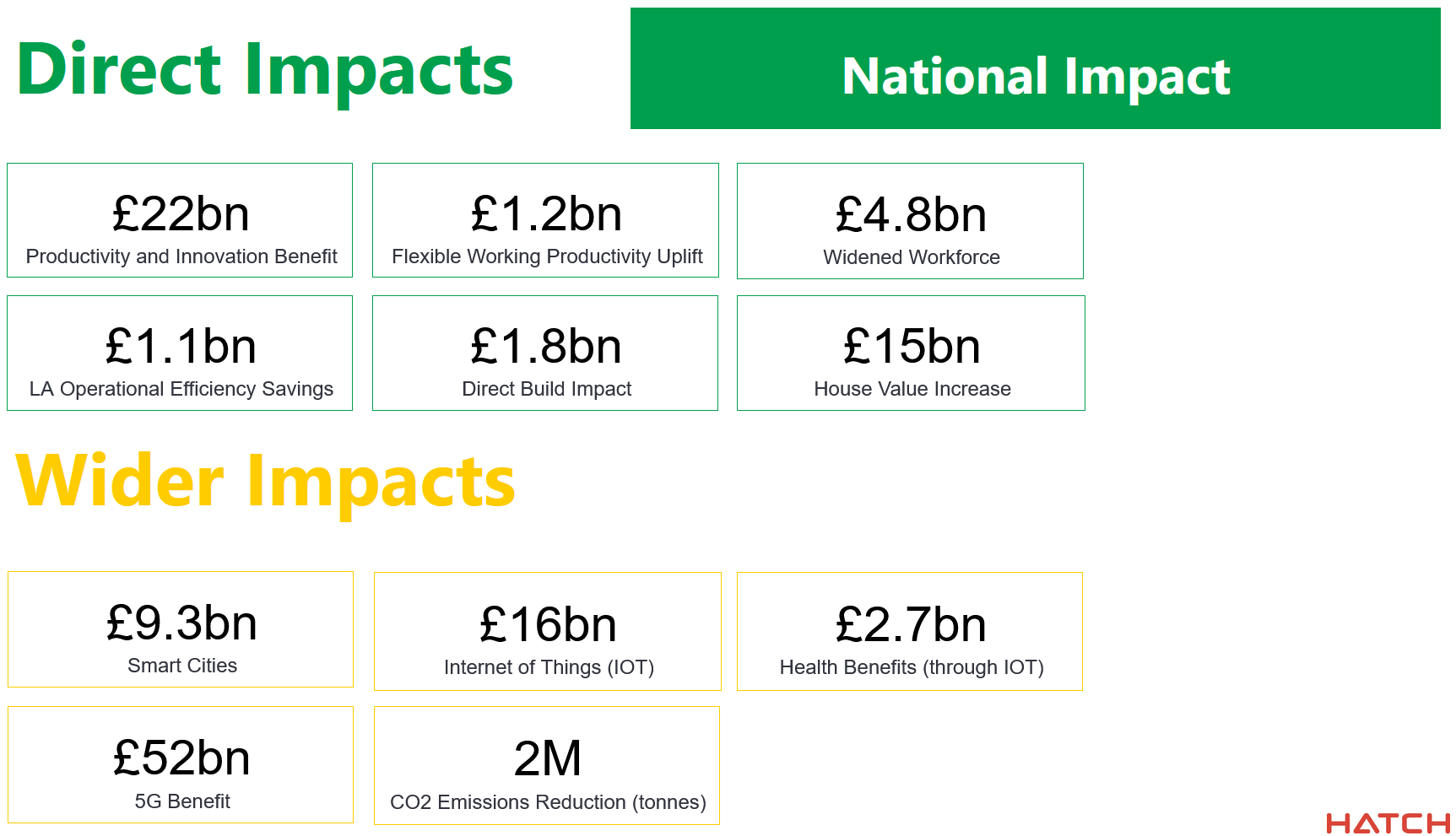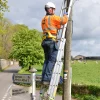Report Claims CityFibre’s FTTP Rollout to Deliver GBP38bn in UK Economic Benefits

A new report from consultancy firm Hatch claims to have identified over £38bn in potential economic benefits – derived over a 15-year period – that could stem from CityFibre’s ongoing UK rollout of a new gigabit-capable Fibre-to-the-Premises (FTTP) broadband ISP network. Naturally, the report was commissioned by CityFibre.
Since 2018 CityFibre has been busy working on a major £4bn investment programme, which has so far enabled their full fibre network to cover 1.5 million UK premises – with 1.3m ‘Ready For Service‘ via a supporting ISP (here). The main aim of this build is to have 8 million premises “substantially completed” – across around 285 cities, towns and villages (c.30% of the UK) – by the end of 2025 (here).
Once complete, this new network is also expected to cover 800,000 businesses, 400,000 public sector sites and 250,000 5G (mobile) access points (masts and rooftop sites etc.). So far, the operator is well on their way to becoming the UK’s third major broadband infrastructure provider, after Openreach (BT) and Virgin Media (VMO2).
Advertisement
The new report from Hatch – ‘Economic Impact of Full Fibre Infrastructure from CityFibre’s Network‘ – predicts that – over a 15-year period (once the network build has completed) – the economic impacts from this will include £22bn in productivity benefits, £4.8bn from a widened workforce and £1.2bn from flexible working (e.g. home working), as well as creating around 16,400 jobs (i.e. within CityFibre’s build partners and supply chain) – generating £1.8bn in incremental GVA. But there’s more.

Hatch also considered the wider benefits that go beyond the core economic benefits of deployment. The report states that CityFibre’s networks will help to unlock £53bn in Gross Value Added (GVA) from 5G services, £16bn from the Internet of Things and £9.3bn from Smart City initiatives. The shift from slow and “power-hungry” copper lines to energy efficient fibre infrastructure is also calculated to save more than 2m tonnes of CO2 emissions.
The report particularly notes that a third of CityFibre’s rollout locations are in places the Government has identified as most in need of “levelling up” investment, which includes a high proportion of locations ranked as being in the 10% most deprived parts of England.
Advertisement
Greg Mesch, CEO of CityFibre, said:
“This report demonstrates just how powerful a tool Full Fibre is in levelling up the UK. Digital infrastructure competition is driving billions of pounds of private investment from incumbents and challengers and every pound spent is unlocking economic growth, new jobs and more efficient public services in some of the most deprived parts of the country. We’re delighted to see the impact of our contribution and we look forward to playing an ever-larger role in future.”
Studies like this tend to crop up a few times each year from different sources, and most of them are not as independent as we would like. But even when they are, the problem remains that trying to accurately gauge the economic impact of deploying faster broadband is notoriously difficult, not least since most premises won’t be starting from a point of zero connectivity (broadband at 30Mbps+ is now available to c.97% of UK premises).
Likewise, we’re all very different in our requirements, and not all businesses benefit from having access to significantly faster broadband speeds than are currently available. Meanwhile, in homes, the biggest economic drivers often stem from your ability to smoothly conduct online shopping, job hunting, banking and similar tasks, which don’t strictly require ultrafast or gigabit connectivity. Not to mention the negative impacts of issues like slow WiFi.
On top of that, this kind of report can also end up forgetting to factor or balance against a realistic impact from overbuild by rivals. For example, CityFibre are building in many of the same urban areas as rival gigabit-capable broadband and FTTP operators, such as Openreach (BT) and Virgin Media (VMO2). Not to mention a rising number of alternative networks (e.g. Hyperoptic, Gigaclear, G.Network, CommunityFibre, Netomnia etc.).
In short, any study that claims to show a huge economic boost should be taken with a pinch of salt, as they’re often overly optimistic. Nevertheless, few could disagree that there does tend to be a strong positive relationship between broadband investment and growth, even if there is an issue of diminishing returns. Nonetheless, what CityFibre has achieved so far is impressive and should not be understated.
Advertisement
Mark is a professional technology writer, IT consultant and computer engineer from Dorset (England), he also founded ISPreview in 1999 and enjoys analysing the latest telecoms and broadband developments. Find me on X (Twitter), Mastodon, Facebook, BlueSky, Threads.net and Linkedin.
« ITS Technology Get GBP100m Funding for UK Full Fibre Rollout






















































As the ol’ aphorism says: He, or she, who pays the piper calls the tune.
Reports commissioned by an enterprise in pursuit of its business (or other) agenda should always be treated with a healthy dose of scepticism and be expected to emphasise the upsides and to de-emphasise or ignore the downsides, especially as the report likely makes use of data supplied by the client that is often not verified by the consultancy in preparation of the report. Always good to read the disclaimers/caveats with such reports.
There seems to be a lot of double counting in this report, specifically by including benefits that are available without City Fibre’s deployment of FTTP. For example, home working for most people does not require FTTP unless they happen to be on relatively slow FTTC connections. The same is true for the IoT, smart cities and health benefits.
When you then consider the amount of current and future overbuild of FTTP networks, the true level of unique value that City Fibre can claim is going to be pretty small. Especially when City Fibre’s current footprint is so much smaller than that of Openreach and its run rate is much slower.
I’m sure that BT will be flattered that City Fibre has copied its long-standing approach to economic impact reporting but the methodology needs quite a lot of adjustment.
Has it even been demonstrated that there is a net economic benefit from more home working? Are reductions in spending (e.g. on travel and lunches/coffees) offset elsewhere?
£15bn for house prices? Whilst FTTP may create a short-term differential in house prices between the haves and have-nots, once it’s available everywhere, that is likely to evaporate. In any case, making housing even more unaffordable than it is already does not seem to be a benefit to society.
Finally, what exactly is the £52bn “5G benefit”? 5G by itself doesn’t do anything, so presumably they are claiming that there is a vast amount of economic activity which 5G enables that isn’t already enabled by home broadband or 4G. Seems very implausible.
There are proven benefits from Hybrid working. Quantifing them though can be difficult
Saving on Office space, REduced congestion and polution, fewer road accidents lower rail cost due to reduced peak demand. Less sickness less stress on emergency services and hospitals
Hi, This is one of those areas that I always find hard to reconcile, As you ask, what does 5G enable that 4G does not? where does £52 billion GVA come from ? I’m far from convinced but happy to be educated.
@Bob. But you can always argue the other side.
What about the loss of garage work for all the cars now off the road the office cleaners jobs and all the lunch time caffee’s supplying lattaes and lunch. The less people that use the railway will that not increase the cost for everyone else?
Great! If only they could hurry up!
Providing peak hour services on the railways is very expensive so a lighter peak load does save money
There will still be offices that need cleaner just smaller offices
What they save on rail fares will e spent more locally so will help support local shopping centres
For most people a decent FTTC connection is adequate. If you are ding CAD work you may need FTTH as you would if you make a lot of use of video conferencing
For most users FTTH would be nice but not essential